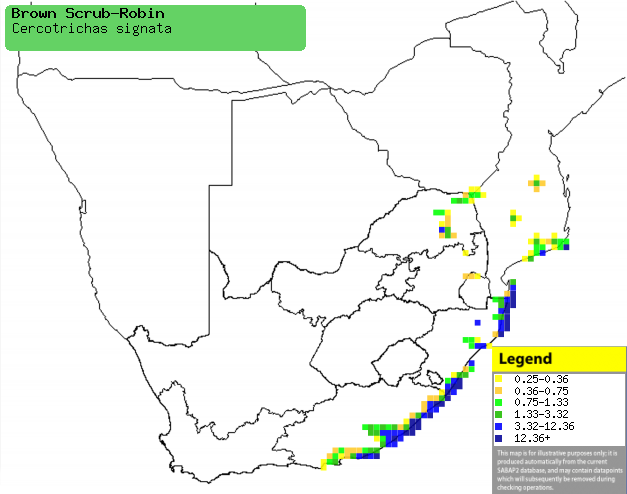|
Cercotrichas signata (Brown
scrub-robin)
[= Erythropygia signata]
Bruinwipstert [Afrikaans]; Bruine
waaierstaart [Dutch]; Agrobate brun [French]; Natalheckensänger [German];
Rouxinol-do-mato-castanho [Portuguese]
Life
> Eukaryotes >
Opisthokonta
> Metazoa (animals) >
Bilateria >
Deuterostomia > Chordata >
Craniata > Vertebrata (vertebrates) > Gnathostomata (jawed
vertebrates) > Teleostomi (teleost fish) > Osteichthyes (bony fish) > Class:
Sarcopterygii (lobe-finned
fish) > Stegocephalia (terrestrial
vertebrates) > Tetrapoda
(four-legged vertebrates) > Reptiliomorpha > Amniota >
Reptilia (reptiles) >
Romeriida > Diapsida > Archosauromorpha > Archosauria >
Dinosauria
(dinosaurs) > Saurischia > Theropoda (bipedal predatory dinosaurs) >
Coelurosauria > Maniraptora > Aves
(birds) >
Order: Passeriformes > Family: Muscicapidae
> Genus: Cercotrichas
Distribution and habitat
Endemic to southern Africa, occurring from southern
Mozambique through to Limpopo Province and South Africa's south-eastern
coastline, from KwaZulu-Natal to the Eastern Cape. It is generally prefers the
understorey of moist coastal and mistbelt forests, especially in dense
vegetation along watercourses and drainage lines. It may also occupy dune forest
and adjacent scrub, valley bushveld and forest dominated by Lebombo-ironwood (Andtostachys
johnsonii).
|
 |
|
Distribution of Brown scrub-robin in southern Africa,
based on statistical smoothing of the records from first SA Bird Atlas
Project (©
Animal Demography unit, University of
Cape Town; smoothing by Birgit Erni and Francesca Little). Colours range
from dark blue (most common) through to yellow (least common).
See here for the latest distribution
from the SABAP2. |
Food
It mainly eats insects, supplemented with fruit and seeds,
doing most of its foraging on damp ground. Most of the time it flicks through
leaf litter to expose food, but it may perform a strange act in which it taps
the ground with one foot then the other, probably to try and flush insects from
their hiding places. It may even follow mole-rats (Cryptomys) and
Porcupines (Hystrix africaeaustralis), pouncing on the insects they
disturb. The following food items have been recorded
in its diet:
- Invertebrates
- Seeds
- Fruit
- Scadoxus puniceus (Snake lily)
- Dracaena aletriformis (Large-leaved dragon-tree)
- Strelitzia nicolai (Coastal strelitzia)
- Trema orientalis (Pigeonwood)
Breeding
- The nest an open cup built of fine twigs, dead leaves, rootlets and moss
and lined with finer rootlets, fibres and animal hair. It is typically
placed in a cavity in a tree trunk or on the top of a hollow stump, about
1-3 metres above ground.
- Egg-laying season is from October-January, peaking during November.
- It lays 2-3 eggs, which are incubated solely by the female for about
14-15 days.
- The chicks are fed by both parents, leaving the nest after about 14-16
days.
Threats
Not threatened, despite the fact that its range is so
localised.
References
-
Hockey PAR, Dean WRJ and Ryan PG 2005. Roberts
- Birds of southern Africa, VIIth ed. The Trustees of the John Voelcker
Bird Book Fund, Cape Town.
|
